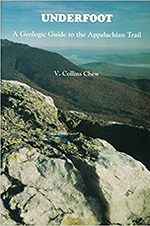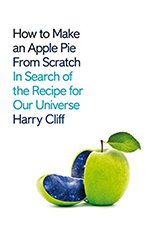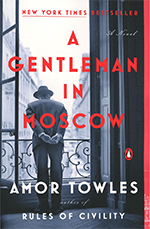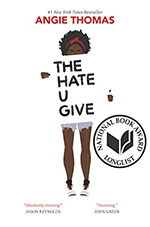Underfoot: A Geologic Guide to the Appalachian Trail, by V. Collins Chew
 Published in 1988 by the Appalachian Trail Conference, this volume is a very AT-focused look at east coast geology. It’s also out of date, and a little hand-wringing when it comes to making clear conclusive statements about the arc of geologic history. The summary of geologic events is written for the beginner, not the professional. There’s lots of talk of forces and cracks and fire and ice, but you won’t hear “chlorite,” “greenschist,” or “mylonite” anywhere herein. And it’s not just eliding jargon; there’s revisionism, too. For instance, “Neoproterozoic” has been rebranded as “Z Time” to make things simpler for the novice. Most of the book is a geography based explication of the rocks found along the trail (as if hiking from Georgia to Maine) and a brief synopsis of their formation stories. The book is in black and white, and attempts to show geographic maps, geologic maps, and paleogeographic maps in a common template, which is a noble goal that is unmet. It would be a good thing to publish a second edition of the book in color, with updated science and a graphical design team.
Published in 1988 by the Appalachian Trail Conference, this volume is a very AT-focused look at east coast geology. It’s also out of date, and a little hand-wringing when it comes to making clear conclusive statements about the arc of geologic history. The summary of geologic events is written for the beginner, not the professional. There’s lots of talk of forces and cracks and fire and ice, but you won’t hear “chlorite,” “greenschist,” or “mylonite” anywhere herein. And it’s not just eliding jargon; there’s revisionism, too. For instance, “Neoproterozoic” has been rebranded as “Z Time” to make things simpler for the novice. Most of the book is a geography based explication of the rocks found along the trail (as if hiking from Georgia to Maine) and a brief synopsis of their formation stories. The book is in black and white, and attempts to show geographic maps, geologic maps, and paleogeographic maps in a common template, which is a noble goal that is unmet. It would be a good thing to publish a second edition of the book in color, with updated science and a graphical design team.
Mapping Mars, by Oliver Morton
 Morton’s first book, and the last one for me to read. I wish I had read it when it came out, for it is a bit dated at this point, a point that I’m sure delights Morton as much as it delights me – We have learned so much more about Mars since 2001; we have explored so much more. The map is more detailed, the processes better constrained. Still, this is a very readable account of about a century of scientific thinking on the red planet. We’re lucky that the past two decades have been so productive in our explorations of Mars, but this shows how we got to where we are. Morton’s style in writing is an absolute delight to read, and he employs a very similar format here as with his other books, The Planet Remade and Eating the Sun: he interacts with key workers in the field, attending their conferences and sharing conversations with them. In Mapping Mars, he also explores imagination’s role in our understanding of Mars, both in terms of driving scientific thinking but also in terms of its influence on fiction. In particular, Morton gives a lot of attention to the work of novelist Kim Stanley Robinson, who made Mars his beat for many years.
Morton’s first book, and the last one for me to read. I wish I had read it when it came out, for it is a bit dated at this point, a point that I’m sure delights Morton as much as it delights me – We have learned so much more about Mars since 2001; we have explored so much more. The map is more detailed, the processes better constrained. Still, this is a very readable account of about a century of scientific thinking on the red planet. We’re lucky that the past two decades have been so productive in our explorations of Mars, but this shows how we got to where we are. Morton’s style in writing is an absolute delight to read, and he employs a very similar format here as with his other books, The Planet Remade and Eating the Sun: he interacts with key workers in the field, attending their conferences and sharing conversations with them. In Mapping Mars, he also explores imagination’s role in our understanding of Mars, both in terms of driving scientific thinking but also in terms of its influence on fiction. In particular, Morton gives a lot of attention to the work of novelist Kim Stanley Robinson, who made Mars his beat for many years.
How to Make an Apple Pie from Scratch: In Search of the Recipe for Our Universe, by Harry Cliff
 An exceptional read about the most basic and most elusive of topics: what is the universe made of? Taking inspiration from Carl Sagan’s Cosmos quip about “If you want to make an apple pie from scratch, you must first invent the universe,” Cliff (a particle physicist) provides a unique and insightful narration for what we now understand matter to be made of, and how we got to understand it. He is a very funny explainer of science, and what I really valued about this book is how well it blends theory and experimental results – I was able (for the first time) to follow the logic of inquiry all the way to the point where it is revealed that particles as such don’t exist, and are instead just vibrations within quantum fields. There’s just the right amount of repetition of key points, and Cliff provides a superb example of the technique of explaining a concept before naming it. Never before have I understood with a gluon does, or why the Higgs boson was such a big deal. All in all, a top-notch piece of popular science writing. Highly recommended.
An exceptional read about the most basic and most elusive of topics: what is the universe made of? Taking inspiration from Carl Sagan’s Cosmos quip about “If you want to make an apple pie from scratch, you must first invent the universe,” Cliff (a particle physicist) provides a unique and insightful narration for what we now understand matter to be made of, and how we got to understand it. He is a very funny explainer of science, and what I really valued about this book is how well it blends theory and experimental results – I was able (for the first time) to follow the logic of inquiry all the way to the point where it is revealed that particles as such don’t exist, and are instead just vibrations within quantum fields. There’s just the right amount of repetition of key points, and Cliff provides a superb example of the technique of explaining a concept before naming it. Never before have I understood with a gluon does, or why the Higgs boson was such a big deal. All in all, a top-notch piece of popular science writing. Highly recommended.
A Gentleman in Moscow, by Amor Towles
 I wouldn’t ordinarily gravitate toward a novel about a Russian count in the aftermath of the Bolshevik revolution, but everyone raved about this book, so during the dark days of the pandemic last winter, I read it… and I loved it. This is what a novel should be – a masterfully told story where you are led into caring deeply about fictional characters. The basic set-up is that the highly-cultured, highly-principled protagonist is imprisoned in a hotel for the rest of his life by the anti-nobility sentiments of the new government, and he makes the best of it, in style. The hotel is a source of luxury items (in particular, the count favors good wine and food) as well as exotic guests, several of whom prove pivotal to the Count’s fortunes. It’s also a source of antagonism, as petty apparatchiks act in ways to constrain the Count and imperil his happiness. But in a way, these plot points are really just foundational architecture for the main show, which is Towles’s tremendous abilities as a writer. I can’t wait to read his other novels.
I wouldn’t ordinarily gravitate toward a novel about a Russian count in the aftermath of the Bolshevik revolution, but everyone raved about this book, so during the dark days of the pandemic last winter, I read it… and I loved it. This is what a novel should be – a masterfully told story where you are led into caring deeply about fictional characters. The basic set-up is that the highly-cultured, highly-principled protagonist is imprisoned in a hotel for the rest of his life by the anti-nobility sentiments of the new government, and he makes the best of it, in style. The hotel is a source of luxury items (in particular, the count favors good wine and food) as well as exotic guests, several of whom prove pivotal to the Count’s fortunes. It’s also a source of antagonism, as petty apparatchiks act in ways to constrain the Count and imperil his happiness. But in a way, these plot points are really just foundational architecture for the main show, which is Towles’s tremendous abilities as a writer. I can’t wait to read his other novels.
The Galaxy, and the Ground Within, by Becky Chambers
 The fourth (and apparently final) novel in the superb Wayfarers series examines issues of culture and community when people of four species are brought together by a crisis and have to isolate in place. I’m not sure if Chambers was influenced by the early COVID lockdown to write this tale of disparate personalities placed into close quarters by circumstance, but it’s a real delight that none of the five main characters are human beings. For those who aren’t familiar with the series, The Long Way to a Small, Angry Planet opens the series with a human protagonist and his alien (to us) spaceship crew. It was followed by A Closed and Common Orbit, which explored what it means to be a person (from the perspective of an AI that inhabits a robot body for the first time). Record of a Spaceborn Few, the third novel, looked at humanity’s future in space, with relatively few appearances by non-human species. To me, the sapient alien species Chambers dreamed up were one of the creative delights of the series, and so it pleased my palate plenty to return to exploring their unique circumstances in this final book. Stars, what a great series!
The fourth (and apparently final) novel in the superb Wayfarers series examines issues of culture and community when people of four species are brought together by a crisis and have to isolate in place. I’m not sure if Chambers was influenced by the early COVID lockdown to write this tale of disparate personalities placed into close quarters by circumstance, but it’s a real delight that none of the five main characters are human beings. For those who aren’t familiar with the series, The Long Way to a Small, Angry Planet opens the series with a human protagonist and his alien (to us) spaceship crew. It was followed by A Closed and Common Orbit, which explored what it means to be a person (from the perspective of an AI that inhabits a robot body for the first time). Record of a Spaceborn Few, the third novel, looked at humanity’s future in space, with relatively few appearances by non-human species. To me, the sapient alien species Chambers dreamed up were one of the creative delights of the series, and so it pleased my palate plenty to return to exploring their unique circumstances in this final book. Stars, what a great series!
The Hate U Give, by Angie Thomas
 A novel that feels all too real, considering the periodically-repeated American tragedy of a white police officer killing an unarmed Black person. The story of the incident is told by a teenage Black girl living in an urban black neighborhood but going to school in the dominantly-white suburbs. Her father is a former gang member and Black Panthers supporter who runs a small grocery store in the neighborhood. She has older and younger brothers, and a supportive mother who works as a nurse. Her friends at school are a mixed race group, and she draws particular support from her white boyfriend. Navigating all this would be complicated enough, but then things go crazy when she witnesses a policeman shoot her childhood best friend, and then the local gangs react, and the media reacts, and politicians react, and the reactions beget more reactions, and the whole situation gets wound up very tightly. Thomas’s writing is extremely effective at drawing the reader into the main characters point of view. She is also a master of dialogue, and I found myself savoring the different diction employed by the various characters, each speaking in a way that evokes their essential circumstances. Top notch, and worth all the praise it has received.
A novel that feels all too real, considering the periodically-repeated American tragedy of a white police officer killing an unarmed Black person. The story of the incident is told by a teenage Black girl living in an urban black neighborhood but going to school in the dominantly-white suburbs. Her father is a former gang member and Black Panthers supporter who runs a small grocery store in the neighborhood. She has older and younger brothers, and a supportive mother who works as a nurse. Her friends at school are a mixed race group, and she draws particular support from her white boyfriend. Navigating all this would be complicated enough, but then things go crazy when she witnesses a policeman shoot her childhood best friend, and then the local gangs react, and the media reacts, and politicians react, and the reactions beget more reactions, and the whole situation gets wound up very tightly. Thomas’s writing is extremely effective at drawing the reader into the main characters point of view. She is also a master of dialogue, and I found myself savoring the different diction employed by the various characters, each speaking in a way that evokes their essential circumstances. Top notch, and worth all the praise it has received.

Couldn’t agree more about Gentleman in Moscow. Wonderful.
In addition to reviewing books about geology, it would be a tremendous public service (at least I would appreciate it) if you were to review geology information sources on the web. There is tons of stuff out there but much of it gives no information about who produced it or what qualifications they have. Beyond videos by Nick Zentner, what can I trust? Thanks.
It’s a good idea – a request for an important service. The thing is, where would I start? I’m not keen on deliberately going out and scouring the dregs of the web just so I can rake someone over the coals. Maybe you can beam me over sources you find and ask for an evaluation? I’m happy to react to specific queries, but not eager to do the searching myself.
Ok.
I am two thirds of the way through How to make an apple pie. I can’t express my disappointment; the proton that participated in the discovery of the Higgs Boson was part of Paul MacCartney’s left middle finger only while part of “Wings”!? Why O why couldn’t it have been present on Ed Sullivan in 1964!!???
The book is …well, why finish it?